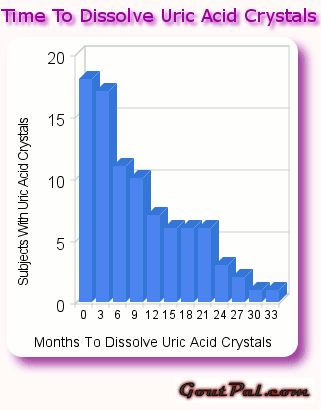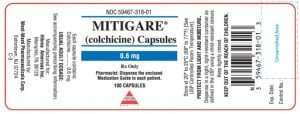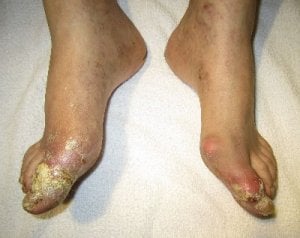Uric acid crystals must be dissolved to permanently get rid of gout pain, but how long does it take to get rid of them?
Like all gouty issues, the answer is never simple. However, we can see some factors that affect the time it takes for crystals to dissolve, and see that the time to start dissolving is now.
In an earlier article, I explained how tophi shrink quicker with lower uric acid concentrations. But this does not mean that once you lower uric acid to a safe level you will immediately stop all gout attacks. In fact, partially dissolved uric acid crystals can start a gout attack, as I explained in Allopurinol Medication: Why It Hurts To Get Rid Of Gout. Though that article looks specifically at allopurinol, the effects of dissolving uric acid crystals might occur with any urate lowering treatment, including diet, until all urate deposits dissolve. But how long does this cleansing period take?
Uric Acid Treatment Phases
Firstly, and most importantly, we have to differentiate two phases of urate lowering treatments. This distinction is not understood by all medical practitioners with the result that inadequate, ineffective dosing of allopurinol is common.
Urate Cleansing Period
The cleansing period requires uric acid levels well below 6 mg/dL (0.35 mmol/L). We have already seen that faster results are obtained below this figure, so it is good to aim for 3 to 4 mg/dL (0.2-0.25 mmol/L) – your Urate Cleansing Target. During the cleansing period, your joints and other tissues still contain crystals that can cause a gout flare. Some doctors prescribe preventative (prophylactic) pain-killers such as colchicine or other anti-inflammatory pain relief.
As we will see soon, it is difficult to determine how long this cleansing phase will take, but easy to see when it has ended. Once you have gone 6 months without a gout flare, whilst maintaining your Urate Cleansing Target, and have no visible uric crystal deposits (tophi), then you are ready to start the uric acid maintenance phase.
Uric Acid Maintenance Period
Once all uric acid crystals have dissolved, the dose of allopurinol, febuxostat or other treatment can be relaxed to maintain a level around 5 mg/dL (0.30 mmol/L), never rising above 6 mg/dL (0.36 mmol/L). The maintenance phase usually lasts as long as you do, but some gout sufferers are able to stop uric acid treatment completely, if only for a few months.
Even if you can stop treatment, it is vital to maintain monitoring at least once, preferably twice, every year. At the first sign of uric acid rising over 5 mg/dL (0.30 mmol/L), you must recommence allopurinol, or other uric acid lowering treatment. Do not wait for a gout attack – the deposits build very slowly, and by the time you notice them you will have sufficient uric acid crystal deposits to give many more months of pain.
Length Of Urate Cleansing Period
There are many variables that determine how long it takes to dissolve all uric acid crystals.
We have already seen that lowering uric acid concentration in the blood will increase the rate at which crystals dissolve. That study[1] reports:
The mean time from onset of ULT [Urate Lowering Therapy] to disappearance of the target tophus for the entire series was 20.8 ± 10.2 months (range 6–64 months)
That study, dealing with sufferers of tophaceous gout, showed that urate clearance could take more than 5 years. A later study[2], amongst other findings concerning relationships between uric acid levels and gout attacks, shows that most gout patients who maintain uric acid levels below 6 mg/dL (0.35 mmol/L) do not have gout attacks after one year. Unfortunately, the study is not directly related to the time it takes to clear urate deposits, focusing more on the occurrence of acute gout attacks.
More relevant, is Pascual & Sivera’s investigation to define the time required for the disappearance of urate crystals from gouty joints[3]. The study analyzes fluid from gouty joints in 18 gout patients who have had gout between 2 months and 40 years, with an average of 10 years. The chart above shows how uric acid lowering medicines reduce the number of gouty subjects who have uric acid crystals in their joints. Most are crystal-free within one year; all but three are crystal free within 2 years; with the final subject becoming gout free within 3 years. The authors note that:
The time required for crystal disappearance ranged from 3 to 33 months, and showed a good correlation with the time since the initial episode of gout (rs = 0.71;p

Dissolve Your Uric Acid Crystals
You can see that dissolving uric acid crystals is a slow process, measured in months and years, rather than days and weeks. However, you can speed the process by:
- Getting uric acid as low as possible during the Urate Cleansing Period
- Start as soon as possible to avoid forming more uric acid crystals.
So organize your urate lowering therapy today.
Leave Dissolve Uric Acid Crystals to browse uric acid crystals in the Understanding Uric Acid Section. Or return to Gout Progression Phase 6 Adjust Uric Acid Cure.
Dissolve Uric Acid Crystals Related Topics
Please remember: to find more related pages that are relevant to you, use the search box near the top of every page.
Common Terms: dissolve, Most Helpful Gout Pages
Other posts that include these terms:
- High Alkaline Foods for Gout Diet Menu
- Gout Foods Table for Vegetables
- Gout Food List for GoutPal Foodies
- Foods High in Uric Acid Chart
- Purine Rich Foods
- Does Alcohol Affect Gout?
- Colchicine For Gout
Dissolve Uric Acid Crystals References
- Perez-Ruiz F, Calabozo M, Pijoan JI, Herrero-Beites AM, Ruibal A. Effect of urate-lowering therapy on the velocity of size reduction of tophi in chronic gout. Arthritis Rheum. 2002;47(4):356-360. Lower Uric Acid for Faster Gout Recovery
- Shoji A, Yamanaka H, Kamatani N. A retrospective study of the relationship between serum urate level and recurrent attacks of gouty arthritis: evidence for reduction of recurrent gouty arthritis with antihyperuricemic therapy. Arthritis Rheum. 2004 Jun 15;51(3):321-5.
- Pascual E, Sivera F. Time required for disappearance of urate crystals from synovial fluid after successful hypouricaemic treatment relates to the duration of gout. Ann Rheum Dis. 2007 Aug;66(8):1056-8. Epub 2007 Jan 12.
Please give your feedback
Did this page help you? If yes, please consider a small donation. Your donations help keep GoutPal's gout support services free for everyone.
If not, please tell me how I can improve it to help you more.
- YouTube
- The gout forums.









